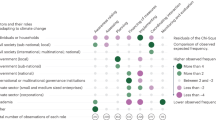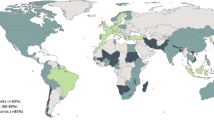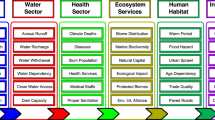Abstract
Weak governance is one of the key obstacles for sustainable development. Undoubtedly, improvement of governance comes with a broad range of co-benefits, including countries’ abilities to respond to pressing global challenges such as climate change. However, beyond the qualitative acknowledgement of its importance, quantifications of future pathways of governance are still lacking. This study provides projections of future governance in line with the Shared Socioeconomic Pathways. We find that under a ‘rocky road’ scenario, 30% of the global population would still live in countries characterized by weak governance in 2050, while under a ‘green road’ scenario, weak governance would be almost entirely overcome over the same time frame. On the basis of pathways for governance, we estimate the adaptive capacity of countries to climate change. Limits to adaptive capacity exist even under optimistic pathways beyond mid-century. Our findings underscore the importance of accounting for governance in assessments of climate change impacts.
This is a preview of subscription content, access via your institution
Access options
Access Nature and 54 other Nature Portfolio journals
Get Nature+, our best-value online-access subscription
$29.99 / 30 days
cancel any time
Subscribe to this journal
Receive 12 digital issues and online access to articles
$119.00 per year
only $9.92 per issue
Buy this article
- Purchase on Springer Link
- Instant access to full article PDF
Prices may be subject to local taxes which are calculated during checkout




Similar content being viewed by others
Data availability
Governance data are available on the Worldwide Governance Indicators website (https://info.worldbank.org/governance/wgi/#home). Historical GDP was obtained from the Penn World Tables 7.0 (https://www.rug.nl/ggdc/productivity/pwt/pwt-releases/pwt-7.0) and projected values through the IIASA SSP database (https://tntcat.iiasa.ac.at/SspDb/). Data on educational attainment and gender equality in education are accessible through the Data Explorer of the Wittgenstein Centre for Demography and Global Human Capital (http://dataexplorer.wittgensteincentre.org/wcde-v2/).
Code availability
Code underlying the results is available at https://github.com/marina-andrijevic/governance2019.
References
IPCC Global Warming of 1.5 °C: An IPCC Special Report (eds Masson-Delmotte, V. et al.) (IPCC, 2018).
Klein, R. J. T. et al. in Climate Change 2014: Impacts, Adaptation, and Vulnerability (eds Field, C. B. et al.) 899–943 (Cambridge Univ. Press, 2014).
Acemoglu, D. & Robinson, J. A. Why Nations Fail: The Origins of Power, Prosperity, and Poverty (Broadway Business, 2013).
Hughes, B. B. et al. Strengthening Governance Globally: Forecasing the Next 50 Years: Patterns of Potential Human Progress (Routledge, 2014).
UN General Assembly Transforming Our World: The 2030 Agenda for Sustainable Development (United Nations, 2015).
Eisenack, K. et al. Explaining and overcoming barriers to climate change adaptation. Nat. Clim. Change 4, 867–872 (2014).
Dasgupta, S. & De Cian, E. The influence of institutions, governance, and public opinion on the environment: synthesized findings from applied econometrics studies. Energy Res. Soc. Sci. 43, 77–95 (2018).
Berrang-Ford, L. et al. Tracking global climate change adaptation among governments. Nat. Clim. Change 9, 440–449 (2019).
Weiler, F., Klöck, C. & Dornan, M. Vulnerability, good governance, or donor interests? The allocation of aid for climate change adaptation. World Dev. 104, 65–77 (2018).
Lesnikowski, A., Ford, J., Biesbroek, R., Berrang-Ford, L. & Heymann, S. J. National-level progress on adaptation. Nat. Clim. Change 6, 261–264 (2015).
Berrang-Ford, L. et al. What drives national adaptation? A global assessment. Climatic Change 124, 441–450 (2014).
Mahmud, T. & Prowse, M. Corruption in cyclone preparedness and relief efforts in coastal Bangladesh: lessons for climate adaptation? Glob. Environ. Change 22, 933–943 (2012).
Mauro, P. Corruption and growth. Q. J. Econ. 110, 681–712 (1995).
Abed, G. T. & Gupta, S. (eds) Governance, Corruption, and Economic Performance (IMF, 2002).
O’Neill, B. C. et al. The roads ahead: narratives for shared socioeconomic pathways describing world futures in the 21st century. Glob. Environ. Change 42, 169–180 (2017).
Samir, K. C. & Lutz, W. The human core of the shared socioeconomic pathways: population scenarios by age, sex and level of education for all countries to 2100. Glob. Environ. Change 42, 181–192 (2014).
Jiang, L. & O’Neill, B. C. Global urbanization projections for the shared socioeconomic pathways. Glob. Environ. Change 42, 193–199 (2017).
Crespo Cuaresma, J. Income projections for climate change research: a framework based on human capital dynamics. Glob. Environ. Change 42, 226–236 (2015).
Leimbach, M., Kriegler, E., Roming, N. & Schwanitz, J. Future growth patterns of world regions: a GDP scenario approach. Glob. Environ. Change 42, 215–225 (2013).
Dellink, R., Chateau, J., Lanzi, E. & Magné, B. Long-term economic growth projections in the shared socioeconomic pathways. Glob. Environ. Change 42, 200–214 (2017).
Crespo Cuaresma, J. & Lutz, W. in Vienna Yearbook of Population Research (eds Muttarak, K. & Jiang, L.) 241–262 (Verlag, 2016).
Rao, N. D., Sauer, P., Gidden, M. & Riahi, K. Income inequality projections for the shared socioeconomic pathways (SSPs). Futures 105, 27–39 (2018).
Kaufmann, D., Kraay, A. & Mastruzzi, M. The Worldwide Governance Indicators: Methodology and Analytical Issues (World Bank, 2010).
Kaufmann, D., Kraay, A., Mastruzzi, M. & Bank, T. W. The Worldwide Governance Indicators Project: Answering the Critics (World Bank, 2007).
Inglehart, R. & Welzel, C. How development leads to democracy: what we know about modernization today. Foreign Aff. 88, 33–48 (2009).
Epstein, D. L., Bates, R., Goldstone, J., Kristensen, I. & O’Halloran, S. Democratic transitions. Am. J. Pol. Sci. 50, 551–569 (2006).
Jha, C. K. & Sarangi, S. Women and corruption: what positions must they hold to make a difference? J. Econ. Behav. Organ. 151, 219–233 (2018).
Kraay, A. & Kaufmann, D. Growth without Governance (World Bank, 2002).
Chen, C. et al. University of Notre Dame Global Adaptation Index Country Index Technical Report (Univ. Notre Dame, 2015).
Brechin, S. R. & Espinoza, M. I. A case for further refinement of the Green Climate Fund’s 50:50 ratio climate change mitigation and adaptation allocation framework: toward a more targeted approach. Climatic Change 142, 311–320 (2017).
Lobell, D. B. & Tebaldi, C. Getting caught with our plants down: the risks of a global crop yield slowdown from climate trends in the next two decades. Environ. Res. Lett. 9, 074003 (2014).
Schleussner, C.-F. et al. Differential climate impacts for policy-relevant limits to global warming: the case of 1.5 °C and 2 °C. Earth Syst. Dyn. 7, 327–351 (2016).
King, A. D. & Harrington, L. J. The inequality of climate change from 1.5 to 2 °C of global warming. Geophys. Res. Lett. 45, 5030–5033 (2018).
Schleussner, C.-F. et al. 1.5 °C hotspots: climate hazards, vulnerabilities, and impacts. Annu. Rev. Environ. Resour. 43, 135–163 (2018).
King, A. D. et al. Emergence of heat extremes attributable to anthropogenic influences. Geophys. Res. Lett. 43, 3438–3443 (2016).
Mace, M. J. & Verheyen, R. Loss, damage and responsibility after COP21: all options open for the Paris Agreement. Rev. Eur. Comp. Int. Environ. Law 25, 197–214 (2016).
Serdeczny, O. in Loss and Damage from Climate Change: Concepts, Principles and Policy Options (eds Mechler, R. et al.) 205–220 (Springer, 2019).
James, R. et al. Characterizing loss and damage from climate change. Nat. Clim. Change 4, 2014–2016 (2015).
Thomas, A. & Benjamin, L. Management of loss and damage in small island developing states: implications for a 1.5 °C or warmer world. Reg. Environ. Change 18, 2369–2378 (2018).
Hegre, H. et al. Forecasting civil conflict along the shared socioeconomic pathways. Environ. Res. Lett. 11, 054002 (2016).
Hallegatte, S. et al. Shock Waves: Managing the Impacts of Climate Change on Poverty (World Bank, 2015).
Hinkel, J., Vuuren, D. P., Nicholls, R. J. & Klein, R. J. T. The effects of adaptation and mitigation on coastal flood impacts during the 21st century. An application of the DIVA and IMAGE models. Climatic Change 117, 783–794 (2012).
Heslin, A., Deckard, N. D., Oakes, R. & Montero-Colbert, A. in Loss and Damage from Climate Change (eds Mechler, R. et al.) 237–258 (Springer, 2019).
NatCatService (Munich RE, accessed 24 January 2018); http://natcatservice.munichre.com/
Schleussner, C.-F., Donges, J. F., Donner, R. V. & Schellnhuber, J. H. Armed-conflict risks enhanced by climate-related disasters in ethnically fractionalized countries. Proc. Natl Acad. Sci. USA 113, 9216–9221 (2016).
Abel, G. J., Brottrager, M., Crespo Cuaresma, J. & Muttarak, R. Climate, conflict and forced migration. Glob. Environ. Change 54, 239–249 (2019).
Burke, M., Hsiang, S. M. & Miguel, E. Global non-linear effect of temperature on economic production. Nature 527, 235–239 (2015).
Heston, A., Summers, R. & Aten, B. Penn World Table 7.0 (Center for International Comparisons of Production, Income and Prices at the Univ. Pennsylvania, June 2011).
Wittgenstein Centre Human Capital Data Explorer Version 2.0 (Wittgenstein Centre for Demography and Global Human Capital, 2018); http://dataexplorer.wittgensteincentre.org/wcde-v2/
van den Boogaart, K. G. & Tolosana-Delgado, R. in Analyzing Compositional Data with R 13–50 (Springer, 2013).
Lutz, W., Cuaresma, J. C. & Abbasi-Shavazi, M. J. Demography, education, and democracy: global trends and the case of Iran. Popul. Dev. Rev. 36, 253–281 (2010).
Acknowledgements
We are grateful to the scientific community for developing the SSP scenarios and to the International Institute for Advanced System Analysis for hosting the SSP database. M.A. and C.-F.S. acknowledge support by the German Federal Ministry of Education and Research (01LN1711A).
Author information
Authors and Affiliations
Contributions
The research was designed by M.A., J.C.C. and C.-F.S. M.A. performed the analysis and created the display items. All authors contributed to the writing of the manuscript.
Corresponding author
Ethics declarations
Competing interests
The authors declare no competing interests.
Additional information
Publisher’s note Springer Nature remains neutral with regard to jurisdictional claims in published maps and institutional affiliations.
Supplementary information
Supplementary Information
Supplementary Tables 1–3 and Figs. 1–7.
Rights and permissions
About this article
Cite this article
Andrijevic, M., Crespo Cuaresma, J., Muttarak, R. et al. Governance in socioeconomic pathways and its role for future adaptive capacity. Nat Sustain 3, 35–41 (2020). https://doi.org/10.1038/s41893-019-0405-0
Received:
Accepted:
Published:
Issue Date:
DOI: https://doi.org/10.1038/s41893-019-0405-0
This article is cited by
-
Climatic risks to adaptive capacity
Mitigation and Adaptation Strategies for Global Change (2024)
-
Global risk assessment of compound hot-dry events in the context of future climate change and socioeconomic factors
npj Climate and Atmospheric Science (2023)
-
Financial inclusion helps rural households address climate risk
Scientific Reports (2023)
-
Adaptation constraints in scenarios of socio-economic development
Scientific Reports (2023)
-
Towards scenario representation of adaptive capacity for global climate change assessments
Nature Climate Change (2023)



